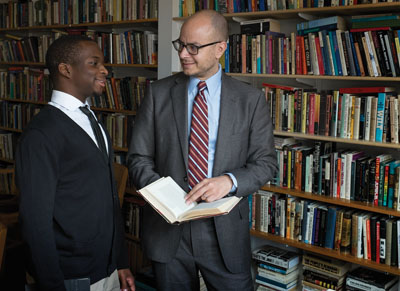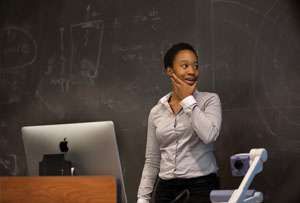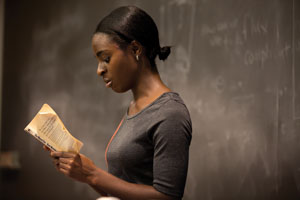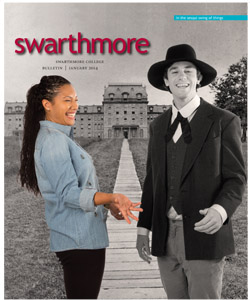Talent Scouts
For 25 years, the Mellon Mays fellowship program at Swarthmore has fostered diversity in the academy

Paul Cato ’14 (left) has benefited immensely from his relationships with Mellon Mays mentors such as Anthony Foy (right), coordinator of the program. Photos by Laurence Kesterson
Phoenix reporter Eric Glover ’07 had no intention of investigating his own life when he entered the Parrish Hall office of Myrt Westphal, associate dean of student life, one day his sophomore year. But after Glover interviewed the now-retired dean for a story on residence life, she turned the questions in his direction.
“I remember telling her I was very interested in dramatic criticism and theater in general,” Glover recalls. “When I matriculated at Swarthmore I thought I would be either a writer or a critic. It never occurred to me that I could also aspire to become a college professor.”
But the notion occurred to Westphal, who nominated Glover for a Mellon Mays Undergraduate Fellowship (MMUF). “The fact that one person thought I could be a competitive applicant was enough reason to go ahead and submit the application,” says Glover, who now has completed all but his dissertation for a Ph.D. in English at Princeton University.
Glover is one of 131 Swarthmore students of color in the last quarter century to be identified as a potential academician and offered mentorship and resources through the MMUF program.
Swarthmore was one of eight charter schools—including Harvard, Yale, and Princeton—that the Andrew W. Mellon Foundation selected in 1988 for a program originally titled the Mellon Minority Undergraduate Fellowship. Its aim was to encourage students of color to consider a career in academe.
According to Chuck James, the Sarah Lawrence Lightfoot Professor Emeritus of English Literature who coordinated Swarthmore’s program from its inception until 2007, the College was selected because it was successful at enrolling highly qualified underrepresented students who would be good prospects for the professoriate.

Naimba Baskerville ’14 presents findings from her summer research during a fall meeting of Swarthmore’s Mellon Mays fellows.
Mellon had “a unique idea to change the face of the academy to better reflect American society,” James explains. Through faculty recommendations, top students of color deemed candidates for the professoriate—rather than medicine or law—were chosen as fellows.
The program has been a revelation to current students just as it was for Glover. Janelle Viera ’14 from Queens, N.Y., came to Swarthmore thinking she could teach English at the high-school level. “At that point I hadn’t seen professors who looked like me,” she says. “But Swarthmore has a diverse faculty in sociology. Seeing my professors helped to spark my interest and show me that I can do this, too. And being involved with the Mellon Mays program helped me see I’m not the only one who feels this way.”
Viera, a sociology and anthropology major, is one of 10 current fellows (three juniors, seven seniors). The program’s name was changed in 2003 to honor Benjamin E. Mays, former president of Morehouse University and author of the first sociological study of African-American religion. At the same time, the mission was broadened to not only increase the number of minority students in academe but encourage those who demonstrate a commitment to eradicating racial disparities. All must plan to pursue a Ph.D. in core fields in the arts and sciences.
Students are nominated in the spring of their sophomore year. Anthony Foy, the associate professor of English literature who coordinates the program, approaches nominees and asks them if they would like to apply. Applicants must submit a personal statement describing their interest in the program, a proposal for a research project, two letters of recommendation, a resume, and a writing sample. A six-person, cross-disciplinary selection committee picks five new fellows each year. Students are matched with a faculty member and receive funding to conduct summer research before entering in the fall as new members of the MMUF cohort.
The mentorship component is a key benefit of the program, says Viera. Of her mentor, Nina Johnson, visiting assistant professor of sociology and faculty coordinator for community-based learning at the Lang Center for Social Change, Viera says, “She is an all-encompassing mentor. I’ve gone to her about grad-school concerns, and I get personal with her. I’m not sure I want to move so far away from my family for grad school. She went through the process not terribly long ago herself.”
Johnson, who is mentoring three Mellon Mays fellows, clearly relishes her role. “All three [Viera, Danielle Fitzgerald ’15, and Eleanor Pratt ’14] are excellent, at the top of their game in class, and are intellectually mastering the material,” she says. “I saw their aptitude for scholarly work and their desire to pursue it.
“As for their summer research—they just attack it,” she continues. “They’re so motivated, so mentoring is not burdensome; it’s a gift. I don’t have to invest time with someone who needs intense supervision. I’m so excited that one is applying to graduate school. I talk with her about applications and essays and who would be good to work with in grad school.”
Viera, whose summer research project explored the income and educational level of the Puerto Rican middle-class community in central Florida, is interested in attending Duke, Northwestern, Harvard, Princeton, Rutgers and UNC–Chapel Hill. “I’m not sure where my heart is yet—they all sound pretty cool.” To sort things out, she says, “I’m meeting with professors Foy and Johnson.”
This year’s Mellon Mays cohort is weighted toward sociology and anthropology, with six of the 10 majoring in that discipline, in part, because its faculty members have so embraced the program, says Foy. According to Johnson, sociology is a natural fit for the program because of its “intersection between theory and practice and connection to the social world. That excites students.” The other four fellows are majoring in biology, with an environmental studies minor; religion, with a black studies minor; English literature; and history, with a black studies minor.
Paul Cato ’14 of Silver Spring, Md., is the religion major. Like Glover and Viera, he entered Swarthmore with another career in mind—working for the United States Department of Justice in civil rights. Soon he realized his initial fields of study, philosophy and political science, “were not for me. I took a course in religion and literature and was surprised. We talked about philosophical topics the way I wanted—in an interdisciplinary way. We talked about the nature of the human condition. Toward the end of 2011, I could see myself teaching these topics and doing research throughout my career, and the idea of law school was not so appealing.”

Mame Nyarko F. Bonsu '14 speaks about her summer research project at a fall meeting of the Mellon Mays fellows.
Foy and Mark Wallace, professor of religion, helped Cato navigate this new direction, straight into the MMUF program. Last summer, with fellowship support, Cato studied one-on-one with a faculty mentor at the University of Chicago. Like many Mellon Mays fellows, his summer research informs his senior thesis—on the Brothers Karamazov and the work of French philosopher Emmanuel Levinas. Cato gave a presentation in July at a national conference—another experience that MMUF encourages fellows to try. “It was nerve-racking, but after I completed the talk, I could see myself in the academy for the rest of my life,” Cato says. His likely grad-school targets are the University of Chicago Divinity School and Princeton’s department of religion.
Further cementing Cato’s vocational resolve this fall was the opportunity to meet past Swarthmore MMUF graduates like Glover, who visited campus in early October to talk about the musical In the Heights. Glover had joined Foy and the fellows two weeks earlier to see the Tony Award-winning production at Philadelphia’s Walnut Street Theater.
“We go to a cultural event each semester,” Foy explains. In the case of In the Heights, “We discussed the meaning of the play, how it worked and connected to what is happening in the world.” Foy also holds program meetings with the fellows five times a semester, addressing topics such as preparing graduate school applications, crafting statements of purpose, and preparing for the Graduate Record Exam.
“I get a lot of personal satisfaction from showing the students the options and joys of an academic career,” Foy says. “I’m doing for others what was done for me as an undergrad. It’s really stimulating and inspiring to work with such remarkable young fellows.” Staying connected with and continuing to advise past mentees, like Glover, also is gratifying.
Glover’s October campus visit had a two-pronged purpose—to further explore the musical and talk about graduate school. “I had a lot of fun sharing my love of musical theater with them and also learning from them,” Glover says. “I also did an exercise where we did a close reading of a paragraph from an academic essay about musical theater to see if we could tease out the argument and translate that argument on representation to Into the Heights. I owe a lot to the Mellon Mays Undergraduate program, so if I can give back in any way, I’m happy to do so.”
Now 18 months away from achieving his Ph.D., Glover envisions teaching at a small liberal arts college, where “students have the opportunity to develop close academic and interpersonal relationships with professors, as I did with Professor Foy. That greatly impacted my academic success at Swarthmore and at grad school.” A college like Swarthmore, he says, “really functions as a community, and everyone is looking out for one another and also holding everybody accountable.”
Glover also could see himself following the path of two members of Swarthmore’s original Mellon cohort, Sean Decatur ’90, newly inaugurated president of Kenyon College, and Garikai Campbell ’90, new provost at Morehouse College. “Seeing them in administrative positions helps me see that I too might become a president or provost of a college,” Glover says.
Glover wasn’t the only MMUF alumnus this fall eager to give back. Sa’ed Atshan ’06 gave a talk on humanitarian politics in the Palestinian Territories, at the invitation of his Mellon Mays mentor, Farha Ghannam, associate professor of anthropology.
A newly minted Harvard Ph.D. in anthropology and Middle Eastern studies who attended a Quaker school in Ramallah on the West Bank before Swarthmore, Atshan is a postdoctoral fellow at Brown University.
“What the [MMUF] program does is allow you to believe in yourself, that you can go to a great grad school and earn a doctorate, and you can become a scholar,” Atshan says. “I hope to inspire and mentor other minority students to believe in themselves. It’s such a privilege.”
Support for Mellon Mays fellows doesn’t end when they start graduate school, he points out. Funds for books, research, and travel to attend retreats centered on dissertation proposal writing and preparation for joining the professoriate as well as meetings with MMUF alumni from around the nation are available.
Since it began in 1988, the MMUF program has expanded to include 39 institutions and a consortium of 39 historically black colleges and universities in the United States; since 2001, the program has also added three South African universities. More than 4,000 undergraduates have been selected as fellows, and 60 percent continue to graduate school, with 35 percent entering Ph.D. programs. There are currently more than 650 fellows pursuing doctoral degrees. To date, more than 500 fellows have earned Ph.Ds., and 60 of those have earned tenure.
The Mellon Mays program is working especially well for Swarthmore, Foy notes, proudly ticking off the latest statistics—“29 Ph.D. recipients in the past 24 years, which means that of our 96 fellows who are five or more years beyond graduation, 30 percent have earned doctorates since the inception of the program.”
Reflecting on the now 25-year-old program, Swarthmore’s first fellowship coordinator, Chuck James, says, “I’m impressed with how the program has worked out for us from the outset. I like the seductive aspect of it. It seduces by incentive, motivation … and some funds.”
 Email This Page
Email This Page